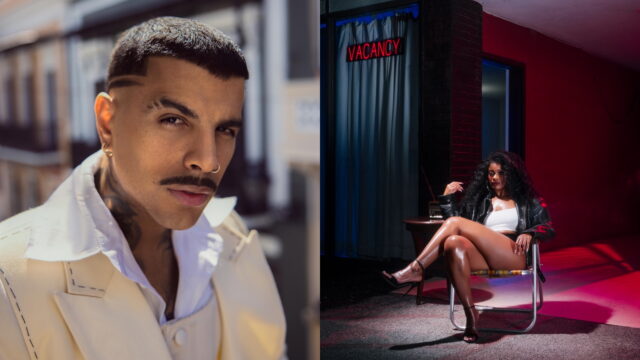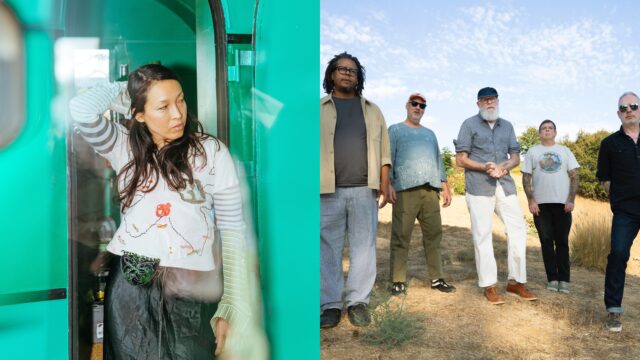The Beatles: The ‘Red’ and ‘Blue’ Albums Reimagined
The landmark 1973 releases firmed up the Beatles’ story and revolutionized the “greatest hits” concept in rock. Now, their newly expanded editions have righted the wrongs of the original LPs and brought the band’s narrative into the immersive ambience of the streaming era.
by Stephen Thomas Erlewine
Paul McCartney spent the better part of 30 years chasing his dream of completing “Now and Then,” a John Lennon demo from the late 1970s that the surviving Beatles attempted to finish for their Anthology project in the 1990s. After Peter Jackson’s crew developed a machine-learning technology during the production of his Get Back documentary, McCartney was finally able to isolate Lennon’s vocal from the piano and noise on the original tape, allowing him to build a lush arrangement around the yearning melody. Once the song was finished, the question arose: Where did this song belong in the extended Beatles universe?
“Now and Then” finds a home as the new closing song on a significantly revised reissue of 1967-1970, the second of a matched set of greatest-hits collections commonly known as the Red and Blue Albums. Both of the compilations have been remixed by Giles Martin, with certain songs benefiting from the same “de-mixing” technology that enabled the Beatles to complete “Now and Then.” They’ve also been expanded in an attempt to address some common complaints about the original incarnations, such as how 1962-1966 — the Red Album — lacked any songs written by George Harrison and shortchanged Revolver, an album often considered the Beatles’ very best. These deluxe 50th-anniversary editions of 1962-1966 and 1967-1970 are further proof that the records, once considered a footnote, even a cash grab, are an essential part of the Beatles’ legacy and, in turn, an indelible part of the pop/rock lexicon.
It’s a far cry from how the Red and Blue Albums were viewed upon their release in 1973. Fifty years ago, 1962-1966 and 1967-1970 appeared to indifference from the band themselves — if not some outright hostility. A year after their release, Paul McCartney told Rolling Stone, “I didn’t take an awful lot of interest in them, actually. I still haven’t heard them.” Part of McCartney’s disdain could possibly have been ascribed to the fact that the two comps appeared the same month as his Red Rose Speedway, leaving his new record to battle his old work on the charts. John Lennon told Melody Maker he didn’t have any input on the final track listing, claiming, “They sent me lists and asked for my opinion but I was busy at the time.”
The Beatles being busy with their own lives and careers in the spring of 1973 is one of the reasons 1962-1966 and 1967-1970 happened: Fixated on the present, they left the past for somebody else. That’s fair. The wounds from the breakup were still fresh, and the group remained embroiled in litigation that would stretch out for another year. The public, though, hungered for a greatest-hits album, something the Beatles didn’t quite have in their catalog. Parlophone rushed out A Collection of Beatles Oldies for the Christmas season of 1966, but it never appeared in America. In the U.S., Capitol was still mopping up odds and ends as late as 1970, when they issued the grab bag Hey Jude, an LP that paired the titular smash with such early hits as “Can’t Buy Me Love.”
Bootleggers stepped into the breach. Late in 1972, the black-market compilation Alpha Omega appeared, brazenly advertised on television as well as in print. A four-LP set that shoehorned in a couple of recent Beatles solo tracks, Alpha Omega sold in large enough numbers to warrant Beatles manager Allen Klein filing an injunction against the pirates. Klein also realized the best way to undercut the bootleggers was to make an official Beatles retrospective. He commissioned Al Steckler, the creative director at Klein’s company ABKCO, to compile a pair of greatest-hits sets that would amount to four LPs, the same length as Alpha Omega.
Klein and Steckler were following a blueprint they created with Hot Rocks 1964-1971, the double-LP Rolling Stones compilation Klein ushered into the marketplace in 1971, a year after the Stones had dismissed him. Hot Rocks relied on the group’s big hits but left space for album cuts that provided color and insight, a formula that flourished on the Red and Blue Albums. At times, the sequencing could seem a little lopsided — 1962-1966 closed with nearly half of Rubber Soul, and the double-LP The White Album is skimmed with three tracks — but the blend of hits, non-LP singles and album cuts did capture the essence of the Beatles’ evolution. That narrative was so strong it transcended the sometimes sloppy execution of the records; several tracks weren’t issued in stereo only because the compilation was assembled in a location where stereo masters couldn’t be found.
The artwork relied on a pair of rhyming photos by Angus McBean, who shot the cover image of the band’s 1963 debut Please Please Me and replicated the pose for Get Back, the scrapped 1969 album that was the first draft of Let It Be. Taken at the start and conclusion of their career, the images provided a swift, haunting illustration of the distance the Beatles traveled in less than a decade which, in turn, helped sell the records: The visible aging in the two photos suggested that there was a story to tell. That hint of a narrative helped carve a place in the public imagination for the Red and Blue Albums, one that gave the compilations a legacy that transcended their origins as a simple repository of hits. The charm of the Red and Blue collections is that they worked as albums, four interlocking sides with their own internal flow.
1962-1966 and 1967-1970 succeeded beyond anyone’s wildest imagination, competing with McCartney’s Red Rose Speedway for the top of the charts and then sticking around as pop perennials. Furthermore, they confirmed that old 45s could be reconfigured as vibrant LPs. Soon, a deluge of imitators flooded the marketplace. Arriving a year later, the Beach Boys’ Endless Summer was a transparent attempt to ride this wave, condensing a career into a double LP, a move mimicked by Creedence Clearwater Revival’s Chronicle in 1976. During the mid- and late 1970s, Elton John, Alice Cooper, Eagles and Steve Miller — all staples of album-rock radio — each distilled their essence onto greatest-hits records, winding up with compilations that rivaled (and sometimes eclipsed) their proper LPs.
The enduring impact of 1962-1966 and 1967-1970 as holistic albums is why the new revisions of these collections are nearly as noteworthy as “Now and Then” and the lively, dynamic new mixes by Giles Martin: These new editions change the flow and the impact of the story. By correcting such routinely acknowledged flaws as the lack of Harrison songs on 1962-1966, the new versions of the Red and Blue Albums are a bit more leisurely. The 1973 editions crammed six or seven songs on each side of an LP, giving the albums a real punch. The 2023 revisions are sequenced not like LPs but like playlists, allowing for slight digressions and offering a more immersive experience. It’s not quite the same vibe as the original records, yet these 50th-anniversary reissues do hearken back to the origins of the Red and Blue Albums. They were conceived to address a need in the marketplace, and that’s precisely what these expansions do too. They repurpose the Beatles to suit the habits of streaming listeners — just like how the originals were designed with an LP audience in mind.



